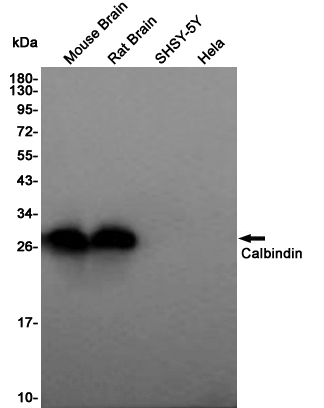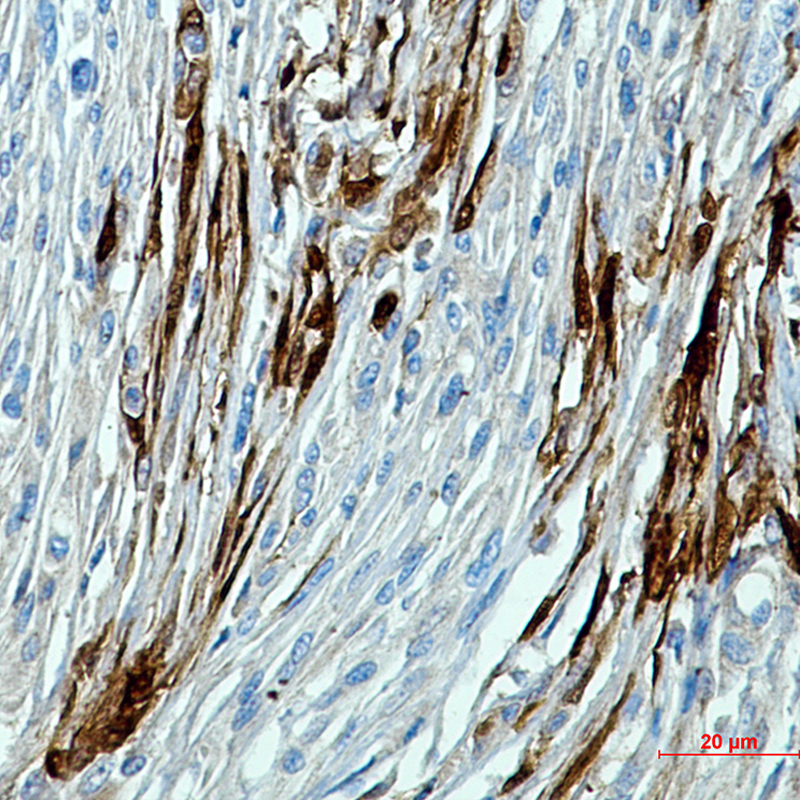

| WB | 咨询技术 | Human,Mouse,Rat |
| IF | 咨询技术 | Human,Mouse,Rat |
| IHC | 1/50-1/100 | Human,Mouse,Rat |
| ICC | 技术咨询 | Human,Mouse,Rat |
| FCM | 咨询技术 | Human,Mouse,Rat |
| Elisa | 咨询技术 | Human,Mouse,Rat |
| Aliases | avian-type; CAB27; CALB1; Calbindin 1 28kDa; Calbindin; D28K; RTVL H protein |
| Entrez GeneID | 793 |
| WB Predicted band size | Calculated MW: 30 kDa; Observed MW: 30 kDa |
| Host/Isotype | Rabbit IgG |
| Antibody Type | Primary antibody |
| Storage | Store at 4°C short term. Aliquot and store at -20°C long term. Avoid freeze/thaw cycles. |
| Species Reactivity | Human,Mouse,Rat |
| Immunogen | A synthetic peptide of human Calbindin |
| Formulation | Purified antibody in TBS with 0.05% sodium azide,0.05%BSA and 50% glycerol. |
+ +
以下是3-4篇关于Calbindin抗体的代表性文献及其摘要概括:
---
1. **文献名称**: *"Calbindin D-28k localization in the rat brain"*
**作者**: Baimbridge KG, Miller JJ
**摘要**: 该研究利用免疫组化技术,首次系统描述了Calbindin D-28k蛋白在大鼠脑部的分布,发现其高表达于小脑浦肯野细胞、海马及皮层神经元,提示其在钙离子缓冲和神经保护中的关键作用。
---
2. **文献名称**: *"Calbindin-D28k immunoreactivity in Alzheimer's disease"*
**作者**: Rogers JH et al.
**摘要**: 通过Calbindin抗体标记,研究发现阿尔茨海默病患者海马和皮层区域的Calbindin阳性神经元数量显著减少,可能与疾病相关的钙稳态失调和神经元退行性病变相关。
---
3. **文献名称**: *"Calbindins in pathological conditions: from molecular mechanisms to therapeutic implications"*
**作者**: Schwaller B et al.
**摘要**: 综述了Calbindin在神经退行性疾病、癫痫及癌症中的表达变化,强调其作为生物标志物的潜力,并讨论了Calbindin抗体在疾病机制研究及诊断中的应用。
---
4. **文献名称**: *"Comparative analysis of Calbindin antibody specificity across species"*
**作者**: Pasteels B et al.
**摘要**: 对比了多种Calbindin抗体在人类、小鼠和大鼠组织中的交叉反应性,验证了部分抗体的物种特异性,为跨物种研究提供了实验选择的依据。
---
这些文献覆盖了Calbindin抗体的基础定位、疾病关联及实验技术验证,可作为相关研究的参考。
Calbindin antibodies are essential tools in neuroscience and cell biology for detecting calbindin proteins, a family of calcium-binding proteins critical for regulating intracellular calcium homeostasis. Calbindin-D28k (CB-D28k) and Calbindin-D9k (CB-D9k) are two major isoforms, with CB-D28k prominently expressed in specific neuronal populations (e.g., cerebellar Purkinje cells, hippocampal neurons) and non-neuronal tissues (e.g., kidney, intestine), while CB-D9k is found in tissues like the duodenum and placenta. These proteins buffer calcium ions, modulate calcium-dependent signaling, and protect cells from calcium-induced excitotoxicity.
Calbindin antibodies are widely used in immunohistochemistry (IHC), Western blotting, and immunofluorescence to map calbindin-expressing cells, study calcium signaling pathways, and investigate neuronal circuitry. Their specificity is validated through knockout controls or peptide-blocking assays. In research, calbindin antibodies help identify selective vulnerability of neurons in neurodegenerative disorders (e.g., Alzheimer’s, Parkinson’s), where calbindin loss correlates with disease progression. They also serve as markers for specific cell subtypes, such as dopaminergic neurons in the substantia nigra or retinal neurons.
Commercially available antibodies are typically raised in rabbits, mice, or goats, targeting conserved epitopes across species (human, rodent, primate). Recent advances in multiplex staining techniques have expanded their utility in co-localization studies with other calcium-binding proteins (e.g., parvalbumin, calretinin). However, users must optimize protocols to address cross-reactivity or background issues. Overall, calbindin antibodies remain indispensable for exploring calcium-mediated physiology and pathology in health and disease.
×